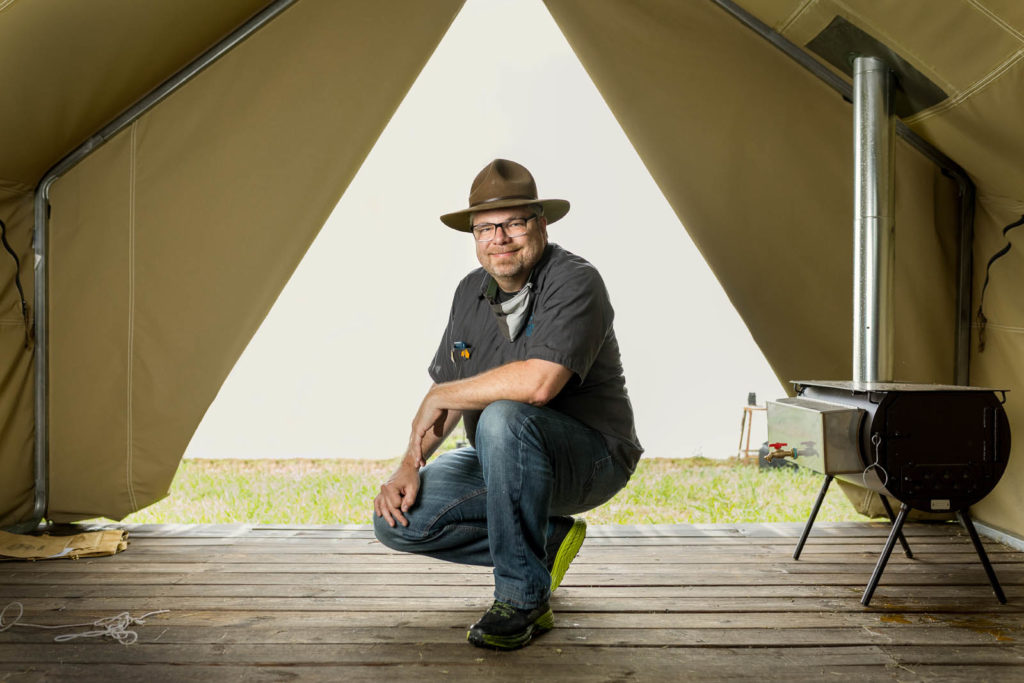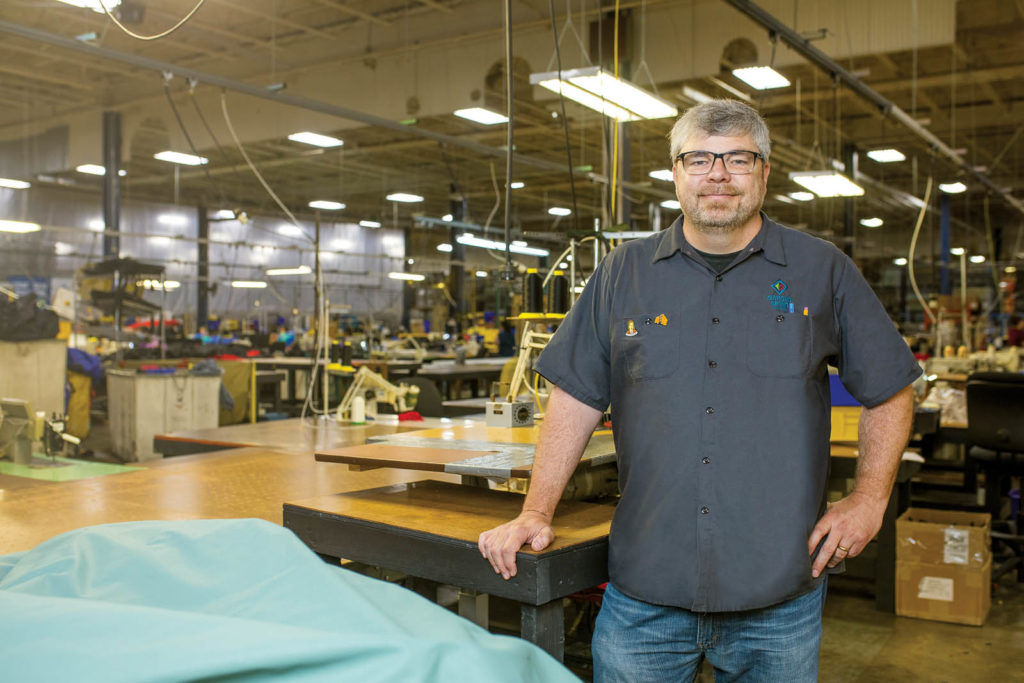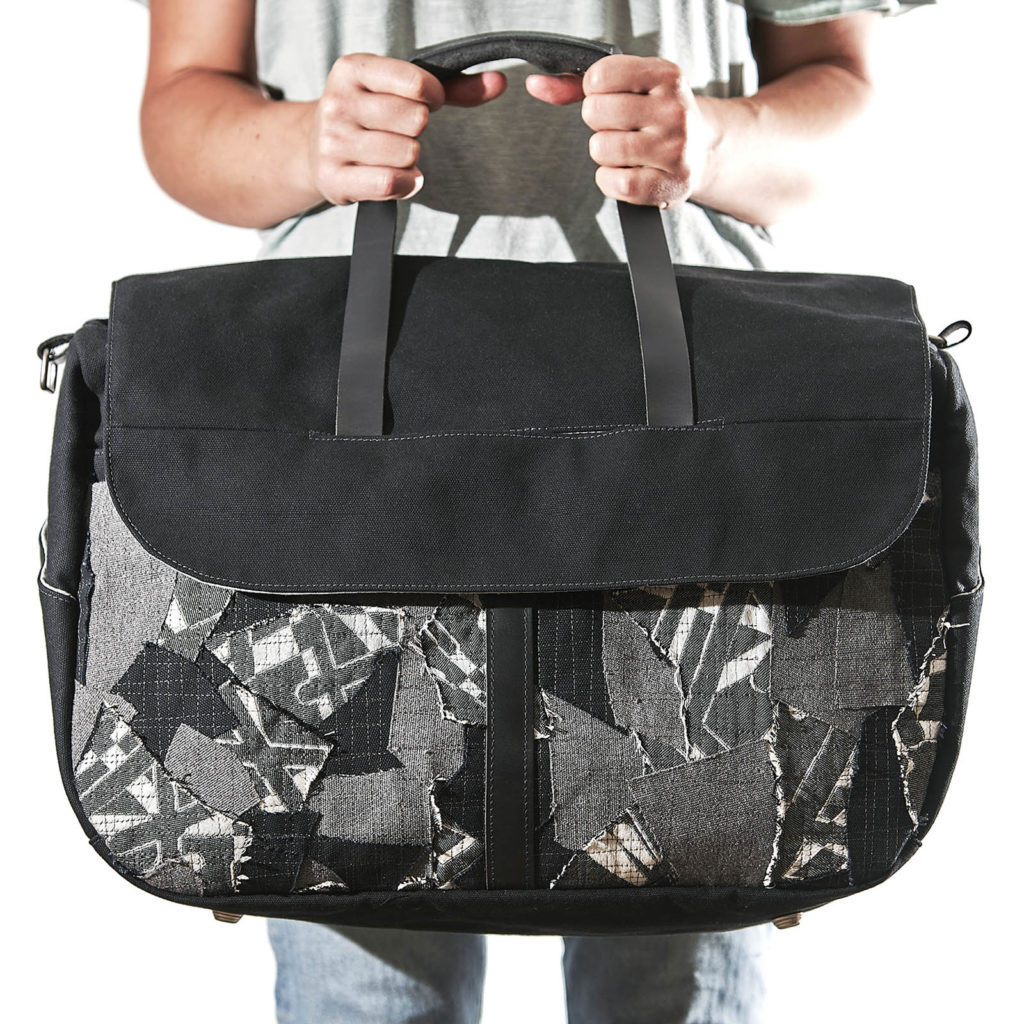John Delaloye combines Diamond Brand Gear’s history and reputation with a strategy that focuses on doing what lower-priced competitors can’t.
by Michelle Miron
I get really pumped about new products, new fabrics, and when we learn from something we’ve researched or read about or seen somewhere and can bring those elements to fruition here,” says John Delaloye, CEO of Asheville, N.C.-based Diamond Brand Gear Co. “We all try to pitch in on R&D.”
Diamond Brand’s willingness to develop new products to meet changing market demands has been a theme in its 139-year history. Founded as a Philadelphia, Pa., fur and leather distributor in 1881, the company moved to New York City before 1920 to help meet demand in canvas drop cloths for painting crews. Through the years its product line expanded to include well-crafted tarps, coverings and utilitarian knapsacks, which helped Diamond Brand land contracts with both the U.S. military and the Boy Scouts of America.

In the 1940s, the company moved its production to North Carolina, and in the 1960s the firm added a contract manufacturing arm that began furnishing tents and outdoor gear to other well-known consumer brands. Through the years, Diamond Brand’s reputation grew as a dependable source of functional, highly durable outdoor shelters and equipment sold through both wholesale and retail channels.
Delaloye came on board in 2005, when his friend Will Gay, owner of the original Diamond Brand, offered him the opportunity to be chief financial officer (CFO) and a minority partner. At the time, Delaloye was a 38-year-old former banker and CFO, and he says he was attracted by the chance to “be more entrepreneurial and creative … and to get my hands dirty.”
That leap of faith set him up for an even greater leadership role in 2015, when Gay decided to sell Delaloye the manufacturing division, while keeping the specialty outdoor retail stores that were also part of the company (Diamond Brand Outdoors and Frugal Backpacker). Logistically, the change was fairly simple; Delaloye kept the production workforce, made some new hires, installed new equipment and technology, and began enacting his own plans for company growth.
“My biggest learning curve was how to day in and day out manage a factory,” he says. “I knew a little about that from a higher level, but now I’m literally in the factory every day.”
New strategies
Delaloye’s focus today is on helping Diamond Brand Gear capitalize on its reputation for quality, durability and ease of customization in what has become a crowded market characterized by significant overseas pressure. This has involved putting a greater focus on Diamond Brand’s summer camp/outdoors programs market, which encompasses everything from national parks services to private campgrounds to traditional youth and family outdoor programs. About 50 percent of its revenue comes from direct sales to end users, and half comes from contract manufacturing partnerships. Only 10 to 15 percent of those contracts are directly linked to the military, whereas years ago, that segment was closer to 70 percent. This diversification has helped Diamond Brand’s business model to be more stable and predictable.
With its direct-to-end-user focus, Diamond Brand is now involved in more of its own design and has expanded its ability to customize products upon request. Delaloye says recent trends have included calming colors that are intended to reduce visual pollution and retro-inspired features that mimic authentic Diamond Brand designs from the 1960s and 1970s.
Another goal for Delaloye and Diamond Brand has been the establishment of design standards that make Diamond Brand products functional and high-performance—yet not so advanced or high-tech that they discourage beginning campers.
“To some extent, we don’t view ourselves as a traditional outdoors company,” he notes. “Our end users are out for longer stays, they want more durable products, and they’re thinking about different things relative to performance. But our philosophy is that we want everyone to have access to camping, so we want products that aren’t intimidating to anyone. Our gear should be simple to use, reliable and hopefully bring about a good experience.”
While he’d like to get rid of the misconception that Diamond Brand is primarily a military supplier, Delaloye says the company is glad to contribute to its country as needed.
“A lot of our product knowledge and design work has come out of our military contracts, and it’s helped make some of the products we make stronger and more durable,” he adds.
Delaloye says Diamond Brand doesn’t even try to compete against overseas price pressure; instead, it focuses on its quality, longevity, ability to customize on demand and nimble turnaround on orders.
“Overseas manufacturers do commodity products really well, so we try not to make commodity products,” he says. “We think about what they can’t do. One strategy is responding quicker; we try to hold onto our raw materials as long as we can, and we can do lower-volume orders for customers because we don’t need a big commitment to make that worthwhile. We make things people want and order, rather than try to design and source products, put a bunch in a warehouse, and hope they sell.”
Whenever possible, the company also tries to capitalize on its long and stable history, its policies toward sustainability, and its mission of helping people get back to nature.
“People now want to know more about a company and brand than just the product itself,” he says. “We’re excited about that. We want people to ask those questions.”
Workforce priorities
Delaloye notes that his management style involves getting to know the company’s 55 employees, learning about their career aspirations, and doing what he can to improve their lives and their jobs.
Three years ago, Diamond Brand workers voted unanimously to keep their 6 a.m. to 2:30 p.m. work shift, which allows them to keep appointments, spend after-school time with their kids, and circumvent the late-day Asheville heat.

“I’m constantly looking for advice relative to making those relationships better and to better support the people I work with,” he says. “I’m most proud of the people and the relationships I’ve helped foster.”
One of his key management philosophies? Question everything.
“Don’t be afraid to ask questions; it’s where new ideas and innovation come from,” he advises. “The worst answer I can get is ‘Because that’s the way I’ve always done it.’”
Because his workforce is a top priority, Delaloye lists his greatest challenge as CEO as being able to effectively manage contract work to produce a steady flow of business. Last year was especially challenging, he notes, because several top clients underwent big changes that negatively affected their Diamond Brand orders. Ten employees were temporarily laid off midyear, but some have since been rehired.
“We focused on the things we did best, tried to keep folks employed doing different things, and added training so they could build their skills,” Delaloye says. “But that was a tough year.”
COVID-19 is making a dent in 2020 revenues, he says, though most customers who bought products for use this summer were able to maintain their orders. The full effects on next year’s sales have yet to be seen, but he remains cautiously optimistic because many people are viewing the outdoors as a safer venue for work and play, particularly when big gatherings are likely. To keep assessing future demand, he’s working closely with the Boy Scouts of America, the American Camp Association and camp owners across the nation.
While 2020 has been a time of uncertainty across the economic spectrum, Diamond Brand is moving forward with strategies that will help it find new customers, experiment with new production techniques and develop new products. The future also calls for an even greater emphasis on Diamond Brand’s consumer products.
“We’re a company whose heart is in the right place,” he concludes. “Hopefully folks will see that. We have to do a better job telling folks about our legacy and history and where we’ve been, since 1881.”
Michelle Miron is a Minnesota-based freelance writer with a 30-year background in journalism and marketing content.
SIDEBAR: Snapshot

Bringing boro into modern textile manufacturing
Dating to 17th-century Japan, boro is a textile tradition that involves carefully sewing together scrap fabric into larger, beautiful pieces that can then be reused to make new gear or simple garments. Diamond Brand Gear Co., Ashville, N.C., is seeking to develop its own 21st-century practice of American boro to differentiate itself from competitors, conserve resources and promote sustainability. The company’s Craft Collection, which features a duffle bag, an overnight bag, a messenger bag and computer bags, has boro incorporated into every piece.
“It’s a project we’re very proud of,” says John Delaloye, Diamond Brand CEO. “It’s valuable because some fabric is hard to come by, and we take those scraps and bring them back to usable form to make creative and unique things. It’s a little more abstract, unique and different.… We’re just kind of having fun with the process and what it allows us to do. We’re especially interested in finding a process that can be done in a manufacturing setting instead of an individual setting, so it’s not such
a labor-intensive process.”
SIDEBAR: Q&A
What advice would you give to young people interested in the custom sewing industry?
The profession of sewing sometimes has an interesting reputation, relative to being just for women or being like home economics class in high school. I’d tell people thinking about sewing work that it’s a way of making or fabricating things, no different from a 3D printer or a table saw in a wood shop. If you’re interested in building or manufacturing, running a sewing machine is a great way to get into the business of making things. And you’ll likely be making some really interesting things.
 TEXTILES.ORG
TEXTILES.ORG


